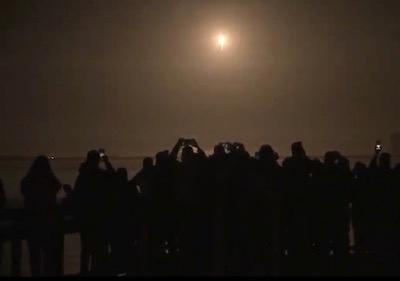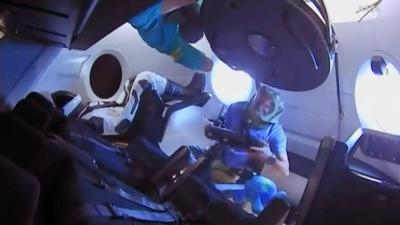Spacecraft Docked To ISS About A Day After Launch
For the first time in history, a commercially-built and operated American crew spacecraft and rocket, which launched from American soil, is on its way to the International Space Station. The SpaceX Crew Dragon spacecraft lifted off at 2:49 a.m. EST Saturday on the company’s Falcon 9 rocket from Launch Complex 39A at NASA’s Kennedy Space Center in Florida.

“Today’s successful launch marks a new chapter in American excellence, getting us closer to once again flying American astronauts on American rockets from American soil,” said NASA Administrator Jim Bridenstine. “I proudly congratulate the SpaceX and NASA teams for this major milestone in our nation’s space history. This first launch of a space system designed for humans, and built and operated by a commercial company through a public-private partnership, is a revolutionary step on our path to get humans to the Moon, Mars and beyond.”
Known as Demo-1, SpaceX’s inaugural flight with NASA’s Commercial Crew Program is an important uncrewed mission designed to test the end-to-end capabilities of the new system. It brings the nation one-step closer to the return of human launches to the space station from the United States for the first time since 2011 – the last space shuttle mission. Teams still have work to do after this flight to prepare the spacecraft to fly astronauts. The best way to advance the system design was to fly this spacecraft and uncover any other areas or integrated flight changes that might be required.
The program demonstrates NASA’s commitment to investing in commercial companies through public-private partnerships and builds on the success of American companies, including SpaceX, already delivering cargo to the space station. Demo-1 is a critical step for NASA and SpaceX to demonstrate the ability to safely fly missions with NASA astronauts to the orbital laboratory.
“First a note of appreciation to the SpaceX team. It has been 17 years to get to this point, 2002 to now, and an incredible amount of hard work and sacrifice from a lot of people that got us to this point...I’d also like to express great appreciation for NASA,” said Elon Musk, CEO and lead designer at SpaceX. “SpaceX would not be here without NASA, without the incredible work that was done before SpaceX even started and without the support after SpaceX did start.”
The public-private partnership combines commercial companies’ unique, innovative approaches to human spaceflight and NASA’s decades-long experience in design, development and operations of a crew space system.
“We are watching history being made with the launch of the SpaceX Demo-1 mission,” said Steve Stich, launch manager and deputy manager of NASA’s Commercial Crew Program. “SpaceX and NASA teams have been working together for years, and now we are side-by-side in control rooms across the country for launch, in-orbit operations and, eventually, splashdown of the Crew Dragon right here off Florida’s coast.”
SpaceX controlled the launch of the Falcon 9 rocket from Kennedy’s Launch Control Center Firing Room 4, the former space shuttle control room, which SpaceX has leased as its primary launch control center. As Crew Dragon ascended into space, SpaceX commanded the Crew Dragon spacecraft from its mission control center in Hawthorne, California. NASA teams will monitor space station operations throughout the flight from Mission Control Center at the agency’s Johnson Space Center in Houston.

The SpaceX Crew Dragon spacecraft docked with ISS at 6:05 a.m. Sunday, March 3. For Demo-1, Crew Dragon carried more than 400 pounds of crew supplies and equipment to the space station and will return some critical research samples to Earth. A lifelike test device named Ripley also traveled on the Crew Dragon, outfitted with sensors to provide data on potential effects on humans traveling in Crew Dragon.
For operational missions, Crew Dragon will be able to launch as many as four crew members and carry more than 220 pounds of cargo, enabling the expansion of the crew members, increasing the time dedicated to research in the unique microgravity environment, and returning more science back to Earth.
The Crew Dragon is designed to stay docked to station for up to 210 days, although the Crew Dragon used for this flight test will not have that capability. This spacecraft will remain docked to the space station only five days, departing Friday, March 8. After undocking from the station, Crew Dragon will begin its descent to Earth. Live coverage of the undocking will air on NASA Television and the agency’s website beginning at 2 a.m., with deorbit and landing coverage resuming at 7:30 a.m.
Additional spacecraft mission objectives include a safe departure from the station, followed by a deorbit burn and parachute deployment to slow the spacecraft before splashdown in the Atlantic Ocean, off the Florida Space Coast. SpaceX’s recovery ship, Go Searcher, will retrieve Crew Dragon and transport it back to port. Teams will be closely monitoring the parachute system and entry control system operation, which have been changed from cargo Dragons to provide higher reliability for crew flights.
NASA and SpaceX will use data from Demo-1, along with planned upgrades and additional qualification testing, to further prepare for Demo-2, the crewed flight test that will carry NASA astronauts Bob Behnken and Doug Hurley to the International Space Station. NASA will validate the performance of SpaceX’s systems before putting crew on board for the Demo-2 flight, currently targeted for July.
NASA’s Commercial Crew Program is working with Boeing and SpaceX to design, build, test and operate safe, reliable and cost-effective human transportation systems to low-Earth orbit. Both companies are focused on test missions, including abort system demonstrations and crew flight tests, ahead of regularly flying crew missions to the space station. Both companies’ crewed flights will be the first times in history NASA has sent astronauts to space on systems owned, built, tested and operated by private companies.
(Source: NASA news release. Images provided)
 ANN's Daily Aero-Term (04.24.24): Runway Lead-in Light System
ANN's Daily Aero-Term (04.24.24): Runway Lead-in Light System ANN's Daily Aero-Linx (04.24.24)
ANN's Daily Aero-Linx (04.24.24) Aero-FAQ: Dave Juwel's Aviation Marketing Stories -- ITBOA BNITBOB
Aero-FAQ: Dave Juwel's Aviation Marketing Stories -- ITBOA BNITBOB Classic Aero-TV: Best Seat in The House -- 'Inside' The AeroShell Aerobatic Team
Classic Aero-TV: Best Seat in The House -- 'Inside' The AeroShell Aerobatic Team Airborne Affordable Flyers 04.18.24: CarbonCub UL, Fisher, Affordable Flyer Expo
Airborne Affordable Flyers 04.18.24: CarbonCub UL, Fisher, Affordable Flyer Expo




